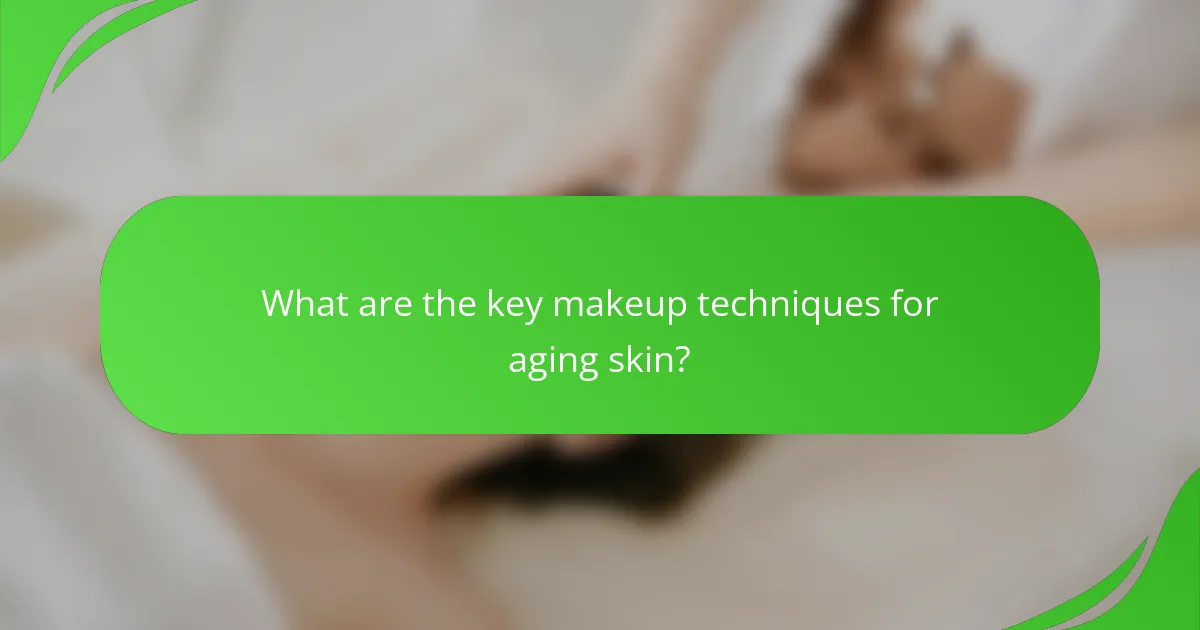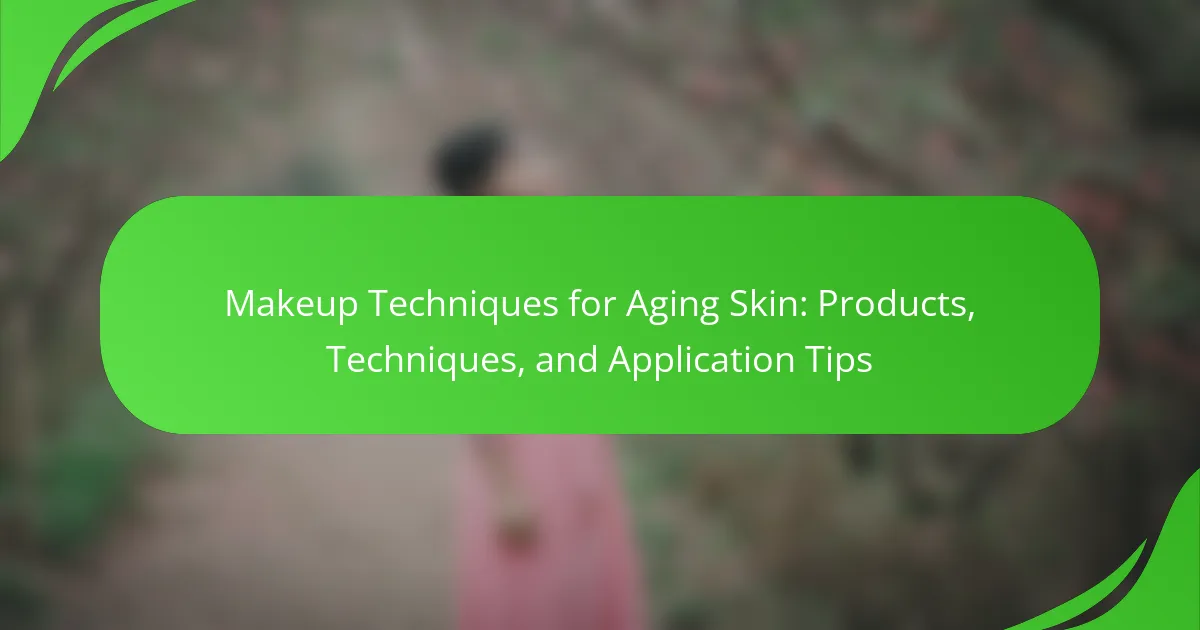Makeup techniques for aging skin focus on enhancing natural beauty while addressing specific concerns such as fine lines and wrinkles. Key strategies include the use of a hydrating primer to smooth the skin’s surface, lightweight foundations that provide coverage without settling into creases, and cream products that offer a youthful glow. Additionally, the careful application of setting powders, highlighters, and lip colors can further improve the overall appearance. This article outlines effective products and application tips to help individuals achieve a radiant look while accommodating the unique needs of aging skin.

What are the key makeup techniques for aging skin?
Key makeup techniques for aging skin include using a hydrating primer, applying lightweight foundation, and utilizing cream products. A hydrating primer helps to smooth the skin’s surface and reduce the appearance of fine lines. Lightweight foundations provide coverage without settling into wrinkles. Cream blush and eyeshadows add a youthful glow and blend seamlessly. Setting powders should be used sparingly to avoid a cakey look. Additionally, using a highlighter on the high points of the face can create a lifting effect. Finally, choosing a lip color that enhances natural tones can brighten the overall appearance. These techniques help to enhance the beauty of aging skin effectively.
How can makeup enhance the appearance of aging skin?
Makeup can enhance the appearance of aging skin by using specific products and techniques. Hydrating primers create a smooth base, reducing the visibility of fine lines. Lightweight foundations provide coverage without settling into wrinkles. Cream blushes add a natural flush and blend seamlessly into the skin. Highlighters can accentuate cheekbones, drawing attention away from imperfections. Setting sprays help maintain a fresh look throughout the day. Additionally, using a light hand during application prevents a cakey appearance. These methods collectively improve the overall look of aging skin, promoting a youthful glow.
What specific techniques are recommended for mature skin?
Hydrating products are recommended for mature skin. They help retain moisture and improve skin texture. Use a hydrating primer before applying makeup. This creates a smooth base for foundation. Cream-based foundations are preferable for mature skin. They provide a dewy finish and do not settle into fine lines. Use lightweight concealers to cover dark circles. Heavy formulas can emphasize wrinkles. Setting powders should be used sparingly. Too much powder can make skin look dry. Finally, opt for cream blushes instead of powder. They blend seamlessly and give a natural glow.
How do lighting and environment affect makeup application on aging skin?
Lighting and environment significantly impact makeup application on aging skin. Proper lighting enhances visibility and helps in achieving an even application. Natural daylight is ideal as it reveals true colors and minimizes shadows. In contrast, harsh fluorescent lights can highlight imperfections and create an unflattering appearance.
The environment also plays a crucial role. Humidity can affect makeup longevity, while dry environments may cause makeup to settle into fine lines. Using a well-lit, controlled environment ensures that makeup is applied smoothly and evenly. Studies indicate that makeup applied in optimal lighting conditions results in a more natural look.
What products are best suited for aging skin?
Moisturizers, serums, and sunscreens are best suited for aging skin. Moisturizers with hyaluronic acid help retain moisture and improve skin elasticity. Serums containing vitamin C boost collagen production and brighten skin tone. Retinol products promote cell turnover and reduce fine lines. Sunscreens with broad-spectrum protection prevent further skin damage. Products with peptides can enhance skin firmness and hydration. Antioxidant-rich creams protect against environmental stressors. These products are essential for maintaining healthy, youthful-looking skin as it ages.
Which ingredients should be prioritized in makeup for aging skin?
Ingredients that should be prioritized in makeup for aging skin include hyaluronic acid, peptides, and antioxidants. Hyaluronic acid hydrates and plumps the skin, reducing the appearance of fine lines. Peptides promote collagen production, enhancing skin elasticity. Antioxidants, such as vitamin C, protect against free radical damage and brighten the complexion. Additionally, ingredients like glycerin and squalane provide moisture and improve skin texture. Formulations containing these ingredients help create a more youthful appearance and improve the overall health of aging skin.
What types of formulations work best for mature skin?
Hydrating formulations work best for mature skin. These formulations often contain ingredients like hyaluronic acid and glycerin. They help retain moisture and improve skin elasticity. Additionally, formulations with peptides can stimulate collagen production. Antioxidant-rich products, such as those with vitamins C and E, protect against environmental damage. Cream-based products are generally more suitable than powders, as they provide a dewy finish. Formulations with SPF are essential to protect mature skin from sun damage. Lastly, gentle exfoliating formulations with alpha hydroxy acids can enhance skin texture.
How can application techniques improve makeup longevity on aging skin?
Application techniques can significantly improve makeup longevity on aging skin. Proper techniques such as using a primer create a smooth base. This helps in minimizing the appearance of fine lines and wrinkles. Applying makeup in thin layers prevents cakiness. Using a damp sponge for blending can enhance the finish. Setting the makeup with a translucent powder locks it in place. Additionally, using a setting spray can provide extra longevity. Research shows that these techniques can extend wear time by up to 12 hours. This is particularly beneficial for aging skin, which may require more attention to detail in application.
What are the best practices for applying foundation on aging skin?
The best practices for applying foundation on aging skin include using hydrating primers and lightweight formulas. Hydrating primers help to create a smooth base and minimize the appearance of fine lines. Lightweight foundations provide coverage without settling into wrinkles.
Applying foundation with a damp sponge or brush ensures an even application. This technique helps blend the product seamlessly into the skin. Avoid using heavy, matte formulas as they can accentuate dryness and texture.
Setting the foundation with a fine, hydrating powder can help maintain a fresh look. This step prevents the foundation from looking cakey throughout the day. Regularly moisturizing the skin before makeup application is essential for optimal results.
Choosing the right shade is crucial for a natural appearance. Testing the foundation in natural light can help ensure the best match. Following these practices can enhance the overall look of aging skin.
How can one effectively apply concealer to minimize imperfections?
To effectively apply concealer and minimize imperfections, start with a clean, moisturized face. Use a primer to create a smooth base. Select a concealer that matches your skin tone closely. Apply a small amount of concealer directly onto the imperfection using a clean brush or your fingertip. Gently tap the concealer to blend it into the skin. Avoid rubbing, as this can disturb the underlying foundation. Set the concealer with a translucent powder to prevent creasing. This method helps achieve a natural finish while effectively covering blemishes.
What common mistakes should be avoided when applying makeup on aging skin?
Common mistakes to avoid when applying makeup on aging skin include using heavy foundation. Heavy foundation can settle into fine lines and wrinkles, making them more noticeable. Another mistake is neglecting to moisturize the skin beforehand. Dry skin can exacerbate the appearance of aging. Using the wrong shade of foundation can also be problematic. An incorrect shade can create an unnatural look. Additionally, applying too much powder can lead to a cakey appearance. This can emphasize texture rather than smooth it out. Skipping primer is another mistake. A good primer helps makeup adhere better and can blur imperfections. Lastly, using harsh colors for eyes and lips can be unflattering. Softer, more muted tones often work better for mature skin.
How can over-application affect the appearance of aging skin?
Over-application of makeup can accentuate the appearance of aging skin. Excess product can settle into fine lines and wrinkles. This settling creates a more pronounced look of aging. Heavy layers can also lead to a cakey appearance. Cakey makeup can draw attention to texture issues. Additionally, over-application may cause skin to appear less luminous. Dullness can make skin look older than it is. Proper application techniques can help mitigate these effects.
What techniques can help prevent makeup from settling into fine lines?
To prevent makeup from settling into fine lines, use a hydrating primer before application. A hydrating primer creates a smooth base, minimizing the appearance of fine lines. Choose lightweight, liquid foundations that offer buildable coverage. These foundations blend seamlessly into the skin without emphasizing texture.
Applying makeup with a damp sponge can help achieve a more natural finish. The sponge distributes product evenly and prevents caking. Setting sprays or powders designed for mature skin can lock in makeup while providing moisture.
Regular exfoliation and moisturizing also contribute to smoother skin texture. Exfoliating removes dead skin cells, allowing makeup to adhere better. Moisturizing keeps the skin plump and reduces the visibility of fine lines.
What tools and accessories can enhance makeup application for aging skin?
Makeup tools and accessories that enhance application for aging skin include makeup sponges, brushes, and setting sprays. Makeup sponges provide a smooth finish and help blend products seamlessly. Brushes allow for precise application, especially in delicate areas. Setting sprays lock in makeup, preventing it from settling into fine lines. Additionally, using a [censured] mist can hydrate the skin during application. Silicone-based primers can smooth out texture and create a better base. Light-reflecting concealers can brighten under-eye areas, reducing the appearance of dark circles. These tools and accessories specifically address the needs of aging skin by promoting hydration and a youthful appearance.
Which brushes or sponges are recommended for mature skin?
For mature skin, soft, synthetic brushes and latex-free sponges are recommended. These tools help apply makeup smoothly without tugging at delicate skin. Synthetic brushes are ideal for cream and liquid products. They provide a flawless finish while minimizing the appearance of fine lines. Latex-free sponges offer a gentle application and can help blend products seamlessly. Using a damp sponge can also hydrate the skin during application. These options are beneficial in enhancing the overall look of mature skin.
How does tool choice impact the final makeup look on aging skin?
Tool choice significantly impacts the final makeup look on aging skin. Different tools can enhance or diminish the appearance of fine lines and wrinkles. For instance, using a damp beauty sponge can provide a more natural finish. This technique helps to blend products seamlessly into the skin. Brushes, especially those with stiff bristles, may emphasize texture and create a less flattering look. Additionally, soft, fluffy brushes can diffuse product, leading to a softer appearance.
Research shows that proper tool selection can improve makeup application techniques. A study published in the Journal of Cosmetic Dermatology indicates that the right tools can minimize the visibility of aging signs. This highlights the importance of using tools designed for delicate skin. Overall, the choice of tools can drastically alter the effectiveness of makeup on aging skin.
What are some practical tips for maintaining a youthful makeup look?
To maintain a youthful makeup look, focus on hydration and lightweight products. Use a moisturizer with hyaluronic acid to plump skin. Apply a primer to create a smooth base. Choose a lightweight foundation or tinted moisturizer for a natural finish. Use cream blush instead of powder to add a healthy glow. Highlight the high points of the face with a liquid highlighter. Set makeup with a hydrating setting spray for longevity. Regularly exfoliate and use sunscreen to protect skin health. These practices create a fresh and youthful appearance.
Makeup Techniques for Aging Skin focuses on effective methods and products designed to enhance the appearance of mature skin. Key techniques include using hydrating primers, lightweight foundations, and cream products to create a smooth, youthful look. The article discusses the importance of proper lighting, suitable formulations, and application techniques that improve makeup longevity and prevent settling into fine lines. Additionally, it highlights essential ingredients and tools that cater specifically to the needs of aging skin, providing practical tips for achieving a fresh and vibrant makeup appearance.


